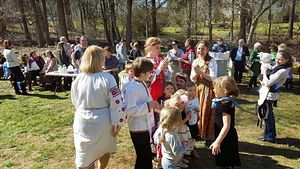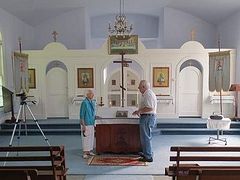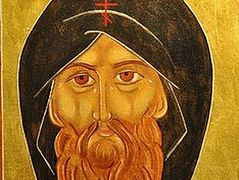Source: The News and Observer
Mebane, March 6, 2016
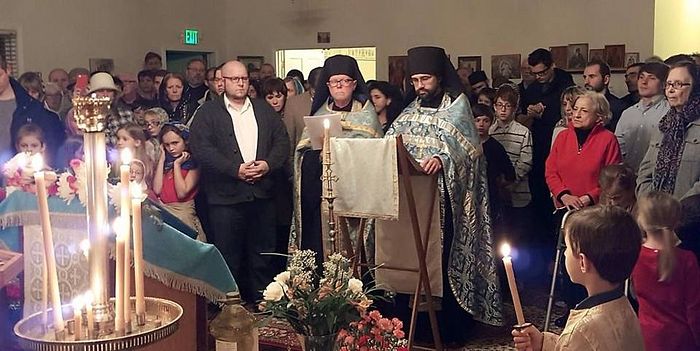 Father (Hieromonk) Gabriel Kvasnikov and a visiting priest lead a special service Feb. 26, 2016, celebrating the visit of the venerated Kursk-root icon of the Mother of God to Holy Trinity Russian Orthodox Church in Mebane, NC. Holy Trinity Russian Orthodox Church Contributed
Father (Hieromonk) Gabriel Kvasnikov and a visiting priest lead a special service Feb. 26, 2016, celebrating the visit of the venerated Kursk-root icon of the Mother of God to Holy Trinity Russian Orthodox Church in Mebane, NC. Holy Trinity Russian Orthodox Church Contributed
The journey to the Holy Pascha – Easter Sunday in the Orthodox Church – begins with a four-week buildup to Great Lent, a 40-day period of strict fasting and prayer.
This week, believers at Holy Trinity Orthodox Church in Mebane – one of three Russian Orthodox churches in North Carolina, with about three dozen members – paused for Meatfare Sunday to reflect on the world’s Final Judgment. It was the last day they will eat meat products until May.
Cheese and other dairy products will be added to the list March 13 at the church on U.S. 70. Cheesefare, also known as Forgiveness Sunday, focuses on Adam and Eve’s expulsion from the Garden of Eden and the need for God’s forgiveness. It is followed by strict Lenten fasting from March 14 to April 30.
It helps to drink more water when fasting, said Lydia Aybar, a member of Holy Trinity for eight years. But it’s also a matter of discipline and faith.
“No prayer is good without faith,” she said.
The church follows the Orthodox calendar, stemming from the older Julian calendar, which is roughly two weeks behind the Gregorian calendar used in Western churches.
Shrouded in history
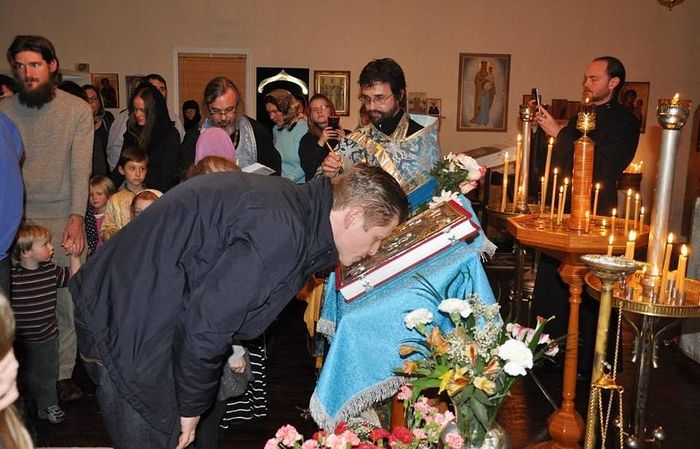 A worshiper kisses the Bible in reverence during a special service at the Holy Trinity Russian Orthodox Church in Mebane, N.C., on Feb. 26, 2016. Holy Trinity Russian Orthodox Church Contributed
A worshiper kisses the Bible in reverence during a special service at the Holy Trinity Russian Orthodox Church in Mebane, N.C., on Feb. 26, 2016. Holy Trinity Russian Orthodox Church Contributed
A passer-by glancing at the clapboard-sided Holy Trinity Orthodox Church in Alamance County might miss the small onion-shaped dome on the roof and the three-barred cross over the door.
Inside, sweet incense and light from layers of candles fill the Russian Orthodox church with hazy smoke. Oriental rugs warm the rough pine floors. A small choir sings a backdrop to worshipers standing silently in prayer for the two- and three-hour services. Scattered benches offer some respite.
Father (Hieromonk) Gabriel Kvasnikov attends the altar – the sanctuary is the church’s holiest place and reserved for clergy – asking for guidance and blessings behind plywood panels adorned with icons of the Mother Mary, Jesus Christ and 2,000 years of apostles and saints.
He pauses in his intonations – recited in Church Slavonic – entering the main room through hinged doors to lead the worshipers, preparing them to receive the bread and wine of communion.
“In Orthodox, we emphasize nobody is pure, nobody is clean,” Father Gabriel said, through a translator. “God, for an Orthodox person, is like a doctor, a savior. He needs a doctor only when he understands that he is sick and wants to be healed.”
Humble beginnings
Holy Trinity is part of the Eastern American Diocese of the Russian Orthodox Church Outside of Russia. The congregation is made up of both Americans who converted or married into the faith and first- and second-generation Russians and Eastern Europeans, some hailing from as far away as Raleigh, Charlotte and Danville, Va. The Triangle attracts many Russian immigrants, they said, for education or to work at the universities and in Research Triangle Park.
After forming in 1991, the church moved from home to home for more than a decade until finding the carpenter’s shop with a small cross in the window for sale on U.S. 70, elder Vladimir Burchakov said.
They opened the church’s doors in 2007; Father Gabriel, a native of St. Petersburg, Russia, arrived in 2011.
Members stand for worship if they are able, because it keeps the mind focused, Father Gabriel said.
“It’s the idea that prayer is like a labor, and when a person has a seat, it usually relaxes them, and their mind also relaxes,” he said. “Standing requires some strength and some internal labor in your mind and your soul.”
Ancient traditions
The faith reflects the unadulterated teachings of Jesus Christ and his apostles, Holy Trinity members said. Greek missionaries from the Byzantine Empire brought those teachings to Russia in the 9th century.
“It is a continuation of the church of the apostles, the one Christ founded on Earth, without any corruption,” said member Aleksander Brooks, an American who converted while studying in Russia.
“I found a very welcoming church,” he said. “I could see the people were really struggling and working out their salvation, and I felt the support that I thought I needed in working out my own salvation.”
The Orthodox Church remained a strong influence in Russia until the 1917 Bolshevik Revolution ushered in communism. The Russian Orthodox Church Outside Russia was formed to serve the diaspora; it reunited in 2007 with its mother church in Russia.
While persecution made it hard to count the Russian faithful, a 2011 report estimated the combined Greek and Russian Orthodox congregation at more than 150 million in more than 60 countries. There are roughly 800,000 Greek and Russian Orthodox members in America, including about 14,000 in North Carolina, according to the 2010 U.S. National Orthodox Census.
The census shows Wake County with 2,000 to 5,000 members, while Alamance and Durham had as many as 300 each.
Special blessing
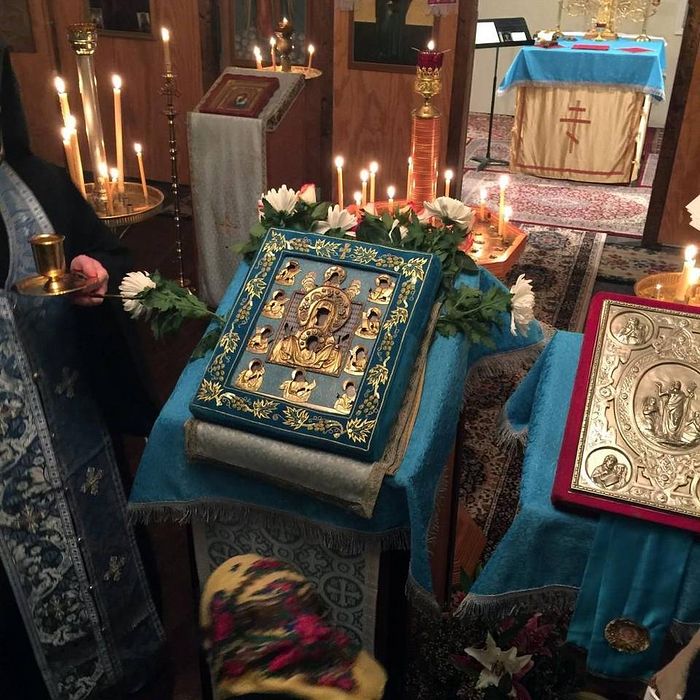 The Kursk-root icon of the Mother of God rests on a stand Friday, Feb. 26, 2016, during services at the Holy Trinity Russian Orthodox Church in Mebane. The icon, dating to the 13th century, was removed from Russia for safekeeping after the Bolshevik Revolution in 1920 and moved around Europe until it was taken to the United States following World War II. It current resides in the Hermitage of Our Lady of Kursk in Mahopak, N.Y. Holy Trinity Russian Orthodox Church Contributed
The Kursk-root icon of the Mother of God rests on a stand Friday, Feb. 26, 2016, during services at the Holy Trinity Russian Orthodox Church in Mebane. The icon, dating to the 13th century, was removed from Russia for safekeeping after the Bolshevik Revolution in 1920 and moved around Europe until it was taken to the United States following World War II. It current resides in the Hermitage of Our Lady of Kursk in Mahopak, N.Y. Holy Trinity Russian Orthodox Church Contributed
Church life is a celebration of both faith and culture, members said. A Feb. 28 visit from the Kursk-root icon of the Mother of God, revered for its ability to effect miracles, was a special blessing, Burchakov said.
The story of the icon, one of the Orthodox Church’s most ancient, starts with a 13th century hunter who found it, unleashing a spring of water when he picked it up. The hunter built a chapel for the icon; its miracles have attracted both visitors and men intent on possessing its powers.
The icon was moved around Europe after the 1917 revolution, arriving in the 1950s at its permanent home in New York. The heavy, wooden icon is adorned with an intricate panel of blue glass and gold-plated silver depicting the Theotokos – the Mother Mary – with her arms outstretched and the Christ child in front of her.
“A priest from South Carolina, who accompanied the icon, said that the icon came to encourage us before the Lent,” Burchakov said. “The icon itself, you could barely see what was painted there because it’s very dark from age.”
The visit capped a busy season, from Christmas on Jan. 7 to the Maslenitsa festival celebrating spring and the Blessing of the Waters at the Eno River commemorating Epiphany and Jesus Christ’s baptism in the Jordan River.
The annual blessing always inspires some members to take an icy dip in the river, Father Gabriel said. Others bottle the water and take it home.
“When we celebrate Epiphany, people want to commemorate that event, and they want also to follow Christ,” Father Gabriel said. “Some of them also want cleansing, symbolically, of their body and their soul.”

